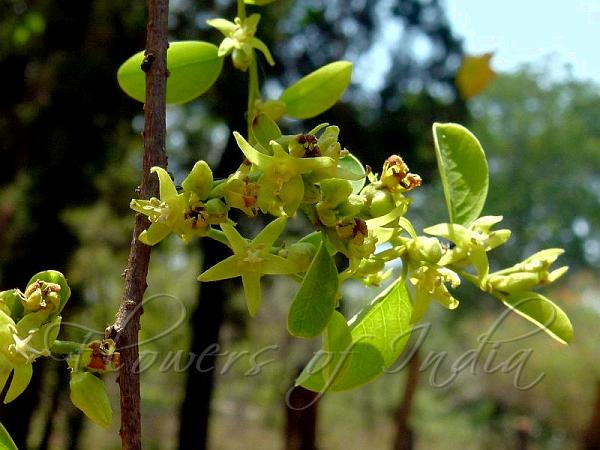|
| Toxic Gooseberry |
|

|

| File size | 153034 |
| Original date | 3/30/14 11:11 AM |
| Resolution | 800 x 600 |
| Flash | Flash did not fire, auto |
| Focal length | 6.8mm |
| Exposure time | 1/250s |
| Aperture | 4.0 |
| Focus Distance | |
| Metering Mode | Multi-segment |
| Camera make | Panasonic |
| Camera model | DMC-FZ100 |
| Sensor type | OneChipColorArea |
|
|
|
|
Photo: |
Botanical name: Cleistanthus collinus Family: Phyllanthaceae (Amla family)
Synonyms: Bridelia collina, Emblica palasis, Lebidieropsis collina
Synonyms: Bridelia collina, Emblica palasis, Lebidieropsis collina
Toxic Gooseberry is a small deciduous tree. Bark is dark brown, almost black, often
with a reddish tinge, rough, peeling in rectangular woody scales. Leaves
are alternate, quite entire, leathery, circular, broadly-obovate or
elliptic, 1.5-3 inches long. Leaf stalk is 6 mm long. Flowers are
yellowish-green, in small silky hairy clusters in leaf axils. Sepals are
ovate-lance-shaped. Petals are as many as the sepals, minute narrow.
Stamens are 5, filaments united in a column in the centre of the disk, and
bearing a pyramidal or 3-lobed pistillode.
Fruit is woody, stalkless, spherical, obscurely 3-rarely 4-lobed,
1.5-2 cm in diameter, dark-brown, shining. The bark is used to poison
fish, and the outer crust of the fruit and the leaves and roots are also
said to be exceedingly poisnous. Toxic Gooseberry is native to the Indian
subcontinent.
| Identification credit: Surajit Koley, Prashant Awale | Photographed in Bengal & Pench Reserve Forest, Maharashtra. |
• Is this flower misidentified? If yes,